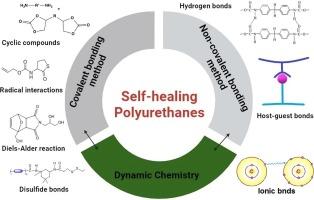Intrinsic self-healing Polyurethanes: Advances, Applications, and future prospects
IF 5.8
2区 化学
Q1 POLYMER SCIENCE
引用次数: 0
Abstract
Polyurethane (PU), a versatile and widely used polymer, has garnered significant research attention due to its intrinsic properties such as extended lifetime and durability, with diverse applications, ranging from clothing to industrial components. Self-healing mechanisms in PU primarily rely on intrinsic and extrinsic driving forces, in which the intrinsic process got sough after because of its reversible features. The intrinsic mechanism can be categorized into reversible covalent bonds (e.g., Diels-Alder reactions and disulfide bonds,) and dynamic non-covalent interactions (e.g., hydrogen bonds and ionic bonds). These mechanisms enable the spontaneous reconfiguration and healing of the polymer structure. Furthermore, the integration of new functional groups into PU structures introduces additional properties such as shape memory, degradability, and biocompatibility, broadening the scope of applications, particularly in flexible sensors and biomedical engineering. This paper delves into the self-healing mechanisms of PU, its functional integration, and potential applications in emerging fields such as coatings, adhesives, photo-thermal conversion, and biomedical devices, highlighting the challenges and future prospects in the development of self-healing PUs. Through a synthesis of recent studies, this article also discusses the balance between self-healing capabilities and mechanical properties, proposing new research directions for enhancing the efficacy and utility of self-healing PUs.

内在自愈合聚氨酯:进展、应用和未来展望
聚氨酯(PU)是一种用途广泛的聚合物,因其固有的特性(如延长使用寿命和耐用性)而备受研究关注,其应用范围从服装到工业部件不一而足。聚氨酯的自愈合机制主要依赖于内在和外在驱动力,其中内在过程因其可逆性而受到追捧。内在机制可分为可逆共价键(如 Diels-Alder 反应和二硫键)和动态非共价相互作用(如氢键和离子键)。这些机制使聚合物结构能够自发地重新配置和修复。此外,将新的功能基团整合到聚氨酯结构中还能带来额外的特性,如形状记忆、可降解性和生物相容性,从而拓宽了应用范围,尤其是在柔性传感器和生物医学工程方面。本文深入探讨了聚氨酯的自愈合机理、功能集成以及在涂料、粘合剂、光热转换和生物医学设备等新兴领域的潜在应用,重点介绍了自愈合聚氨酯的发展挑战和未来前景。本文还通过对最新研究的综述,探讨了自愈合能力与机械性能之间的平衡问题,为提高自愈合聚氨酯的功效和实用性提出了新的研究方向。
本文章由计算机程序翻译,如有差异,请以英文原文为准。
求助全文
约1分钟内获得全文
求助全文
来源期刊

European Polymer Journal
化学-高分子科学
CiteScore
9.90
自引率
10.00%
发文量
691
审稿时长
23 days
期刊介绍:
European Polymer Journal is dedicated to publishing work on fundamental and applied polymer chemistry and macromolecular materials. The journal covers all aspects of polymer synthesis, including polymerization mechanisms and chemical functional transformations, with a focus on novel polymers and the relationships between molecular structure and polymer properties. In addition, we welcome submissions on bio-based or renewable polymers, stimuli-responsive systems and polymer bio-hybrids. European Polymer Journal also publishes research on the biomedical application of polymers, including drug delivery and regenerative medicine. The main scope is covered but not limited to the following core research areas:
Polymer synthesis and functionalization
• Novel synthetic routes for polymerization, functional modification, controlled/living polymerization and precision polymers.
Stimuli-responsive polymers
• Including shape memory and self-healing polymers.
Supramolecular polymers and self-assembly
• Molecular recognition and higher order polymer structures.
Renewable and sustainable polymers
• Bio-based, biodegradable and anti-microbial polymers and polymeric bio-nanocomposites.
Polymers at interfaces and surfaces
• Chemistry and engineering of surfaces with biological relevance, including patterning, antifouling polymers and polymers for membrane applications.
Biomedical applications and nanomedicine
• Polymers for regenerative medicine, drug delivery molecular release and gene therapy
The scope of European Polymer Journal no longer includes Polymer Physics.
 求助内容:
求助内容: 应助结果提醒方式:
应助结果提醒方式:


